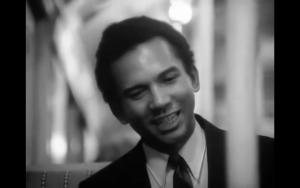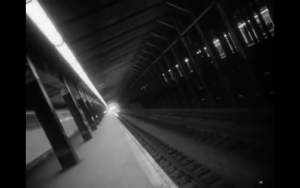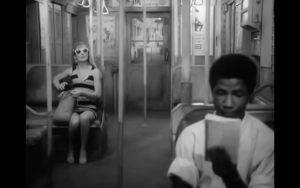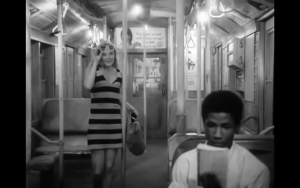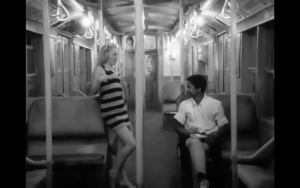Clay/Lula: A Shot by Shot Analysis
After watching the ending of Amiri Baraka’s Dutchman in class, I wanted to further explore Clay and Lula as symbols of black and white America. The following shot by shot analysis looks at the ways in which camera angles and mise en scène (everything in front of the camera) interact with the dialogue, and ultimately advance this duality…
A. “They’ll murder you, and have very rational explanations. Very much like your own.”
In his final speech, Clay warns Lula that the day will arrive when black America will turn to a forceful/violent response after centuries of being victims of murder. The silver/white appearing subway pole slices through the image in a jarring fashion. The way the pole intrudes on the image seems to undercut his message and foretell that he is Lula/white America’s next victim.
B. “Sorry is right.”
As Lula stabs Clay, an invasive close-up creates anxiety as she literally and violently invades his space. Complete with sound and score, she seems the devil incarnate at the climax of a horror film.
C. The next stop.
This interlude of exterior shots sets the stage for the final scene. Here, a dutch angle creates tension. We are back where we started at the beginning of the film, yet the camera angle is distorted, producing a psychological uneasiness; as spectators, we’ve been here before, and we know the horrors that lie ahead.
D. The ride of violence continues.
Lula and another black man, a second Clay so to speak, are positioned on a diagonal. The man–close to the spectator–looks like a prey, unaware that he is being hunted in the distance.
Lula removes her sunglasses, ready to use her eyes to seduce a victim. Aesthetically, her position on-screen is elevated. She harbors a privileged authority.
The final shot visually creates a sense of duality as the subway pole divides the image and races in two. While the second Clay sits in the confines of his own space, Lola caresses the divide with her leg. An anxiety brews as we await the moment her leg will straddle over the border, invading his space. As the camera zooms out, we are left to confront the tension of this vicious cycle of violation of space and bodies.


